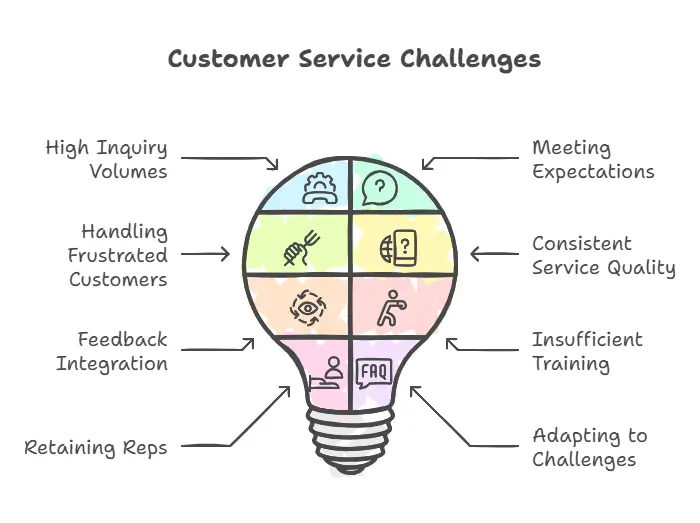Every customer interaction matters, doesn’t it? A single mishandled inquiry or an overlooked concern can create a lasting impression—often not the one you desire. For SaaS companies, e-commerce businesses, and SMEs, customer service challenges can quietly emerge and begin to undermine trust, satisfaction, and loyalty.
This article outlines eight common hurdles that customer service teams encounter and how these issues may be damaging your reputation. Throughout, we’ll discuss actionable strategies, innovative solutions like video customer support, and tips for transforming dissatisfied customers into loyal advocates.
If your goal is to boost customer satisfaction, optimize your customer support team, and provide outstanding customer service, you’re in the right spot. Let’s get started.
8 Customer Service challenges

1. Managing High Volumes of Customer Inquiries
Every business aspires to grow, but scaling too quickly without the right systems can lead to chaos. Juggling multiple customers across various communication channels can overwhelm your customer service agents, especially during peak times or unexpected service outages.
Why It Matters
Ignoring or delaying customer requests can result in dissatisfied customers. The consequences? Increased churn, negative reviews, and a damaged reputation. For small teams, keeping pace with rising demands can feel impossible.
How to Overcome It
- Leverage Customer Service Software: Tools like Zendesk or Freshdesk help centralize customer interactions across channels, minimizing the risk of missing a query.
- Prioritize Training: Equip your support agents with the skills needed to handle high-pressure situations effectively.
- Use AI for Support: Chatbots can manage routine questions, allowing your customer service reps to focus on more complex issues.
Enhancing your customer service efforts not only improves your brand’s image but also fosters trust and loyalty among your audience.
2. Failing to Meet Customer Expectations
Today’s customers expect support that is not only fast but also personal and straightforward. If your team falls short of these expectations, customers may seek alternatives.
Why It Matters
When customers anticipate quick solutions and smooth experiences, anything less can feel like a letdown. Failing to meet these expectations can harm both customer satisfaction and loyalty.
How to Overcome It
- Anticipate Customer Needs: Leverage data from previous interactions to pinpoint pain points and address them proactively.
- Multiple Communication Channels: Provide support via email, chat, phone, and social media to connect with customers on their preferred platforms.
- Exceed Customer Expectations: Small gestures like follow-ups or resolving issues before they escalate can create lasting positive impressions.
3. Handling Frustrated Customers
Every business faces frustrated customers, whether due to product issues, delayed responses, or miscommunication. Mishandling these situations can heighten customer frustration and lead to dissatisfaction.
Why It Matters
Frustrated customers are more inclined to leave negative reviews, cancel subscriptions, or publicly share their bad experiences. This not only harms your reputation but also erodes trust in your brand.
How to Overcome It
- Active Listening: Train customer service representatives to listen attentively to customers without interruptions, ensuring they feel understood.
- Empathy and Apologies: A genuine acknowledgment of the problem and a promise to resolve it can make a significant difference.
- Follow-Up: After resolving the issue, reach out to the customer to confirm their satisfaction. This shows your dedication to providing outstanding customer service.
Also Read : How to Handle Customer Complaints and Win Them Over
4. Delivering Consistent Service Quality Across Channels
Managing various communication channels—email, phone, chat, and social media—can feel overwhelming for customer service teams. Without a cohesive system, inconsistencies can emerge, resulting in gaps in the customer experience.
Why It Matters
Customers anticipate smooth service operations, no matter how they reach out. Any decline in service quality across different channels can lead to confusion and diminish loyalty.
How to Overcome It
- Adopt a Customer Support Platform: Utilize tools like HubSpot or Zoho to ensure all customer interactions are recorded in one location, enabling support agents to respond quickly and uniformly.
- Create Standard Operating Procedures (SOPs): Establish workflows for addressing issues, guaranteeing consistent responses across all channels.
- Train Support Teams on Multitasking: Prepare customer support representatives to efficiently manage and prioritize issues across various platforms.
5. Lack of Customer Feedback Integration
Disregarding customer feedback is akin to driving without visibility—you overlook crucial insights that could enhance your service quality and product offerings.
Why It Matters
Feedback reveals customer needs and challenges, presenting opportunities to improve your customer service initiatives. Neglecting it risks alienating your audience by not meeting their expectations.
How to Overcome It
- Collect Feedback Proactively: Implement surveys, review requests, or post-interaction forms to gather insights after each customer service encounter.
- Close the Loop: Acknowledge feedback, whether it’s positive or negative, and inform customers that their input is appreciated.
- Analyze Trends: Regularly assess feedback to identify recurring customer service issues and address them effectively.
Also Read : Collect Customer feedback : A Complete Guide 2025
6. Insufficient Training for Customer Support Teams
Customer support agents who lack adequate training often find it challenging to tackle complex issues or meet the service expectations of customers. This shortfall affects both the quality of service and the overall customer experience.
Why It Matters
When teams are not properly trained, it results in inconsistent service, longer resolution times, and dissatisfied customers. This not only lowers customer satisfaction scores but also raises turnover rates among support representatives, perpetuating a cycle of inefficiency.
How to Overcome It
- Robust Onboarding: Ensure that new hires receive thorough training on tools, processes, and company values so they are well-prepared from the start.
- Scenario-Based Learning: Use real-world scenarios to train support agents, allowing them to practice handling both common and unique customer service challenges.
- Ongoing Education: Provide regular workshops, e-learning modules, and certification opportunities to keep your team updated on customer needs.
7. Difficulty Retaining Experienced Customer Service Reps
High turnover rates in the customer service department pose a significant challenge. Losing experienced support agents disrupts workflows, increases training expenses, and negatively impacts service quality.
Why It Matters
Keeping skilled customer service representatives ensures continuity and helps uphold a high standard of service. Frequent staff changes can lead to inconsistencies that frustrate customers.
How to Overcome It
- Career Development Opportunities: Create pathways for promotion or lateral moves within the company to keep employees engaged and motivated.
- Recognition and Rewards: Celebrate exceptional performance to inspire your team and build loyalty.
- Supportive Work Environment: Offer the necessary tools, manageable workloads, and mental health resources to help reduce burnout.
8. Adapting to Unique Customer Service Challenges
In today’s fast-paced market, businesses encounter distinct customer service challenges such as increasing customer expectations, varied preferences, and changing communication trends.
Why It Matters
If businesses fail to adapt, their service may seem outdated, leading to customer dissatisfaction and a willingness to switch to competitors who offer more modern solutions.
How to Overcome It
- Innovative Solutions: Implement tools like chatbots or video support to address the changing demands of customers.
- Personalized Customer Journeys: Utilize customer data to customize responses according to individual preferences and previous interactions.
- Stay Agile: Continuously assess your customer service operations to pinpoint areas for improvement or innovation.
Conclusion: Turning Challenges Into Opportunities
Every business faces customer service challenges, but the silver lining is that each challenge offers a chance for improvement. By providing your customer service teams with the right tools, training, and processes, you can convert obstacles into successes.
Taking proactive measures such as responding to customer feedback, utilizing customer service software, and ensuring consistent service quality can elevate your customer service initiatives into a competitive edge. When executed effectively, these strategies not only resolve issues but also boost customer satisfaction and loyalty, enabling your brand to flourish.
FAQs
1. What are the most common customer service challenges?
The most common customer service challenges include dealing with a high volume of inquiries, meeting customer expectations, and managing difficult customers. Additionally, businesses often face issues with inconsistent service quality across various communication channels and the need to adapt to individual customer demands.
2. How can businesses improve customer satisfaction scores?
To improve customer satisfaction scores, businesses should prioritize proactive service, ensure quicker response times, and utilize customer service platforms to streamline interactions. Offering personalized responses and actively listening to customer feedback are also crucial for enhancing satisfaction.
3. What tools help overcome customer service challenges?
Tools that help address customer service challenges include popular options like Desku, Freshdesk, and HubSpot. These platforms centralize customer interactions and provide features such as chatbots, ticketing systems, and analytics to enhance service quality.
4. How do I train my customer service reps effectively?
To train customer service representatives effectively, it’s important to implement scenario-based learning, conduct regular workshops, and provide access to e-learning modules. Training should focus on managing frustrated customers, resolving complex issues, and exceeding customer expectations.
5. Why is retaining support agents so important?
Retaining support agents is vital because experienced representatives contribute to consistency, quicker problem resolution, and a deeper understanding of the brand’s customer service operations. Keeping them on board can significantly boost overall efficiency and customer satisfaction.


